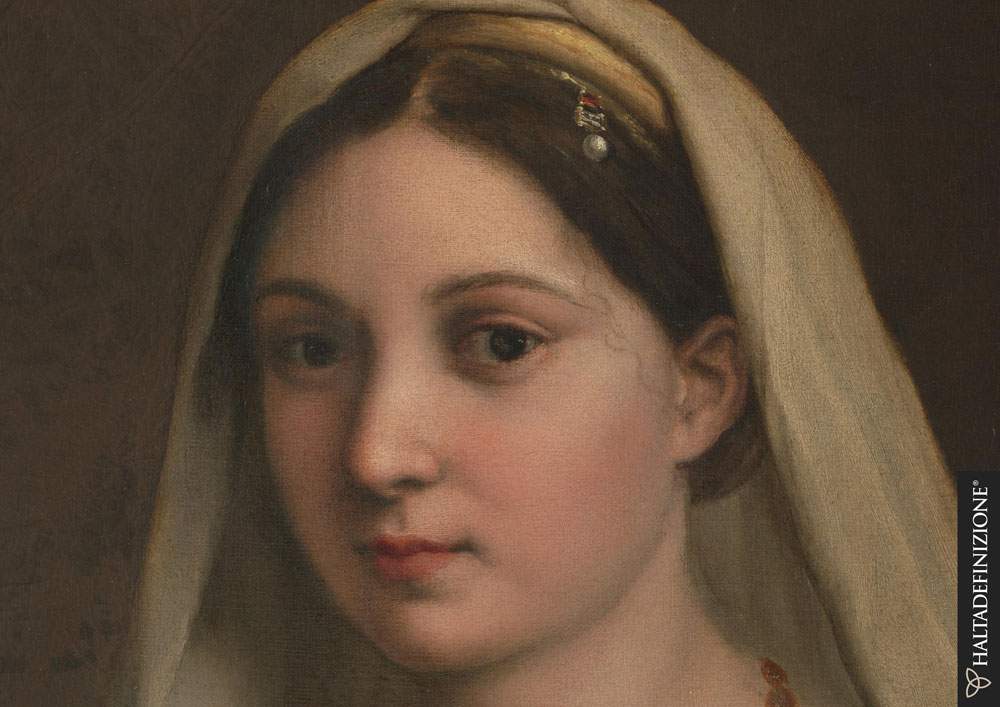Digitized in gigapixels six Raphael masterpieces held at the Uffizi Galleries
Six new works by Raphael have been digitized in gigapixels: in fact, the artistic heritage enhancement operations carried out by Haltadefinizione, a tech company of Franco Cosimo Panini, continue. These are six masterpieces housed at the Galleria Palatina in Palazzo Pitti and at the Uffizi: the Veiled, the Madonna of the Grand Duke, the Portrait of Cardinal Bibbiena, the Portrait of Tommaso Inghirami known as Phaedra, the Portrait of a Young Man with a Pommel and the St. John the Baptist. These are thus added to the virtual gallery of Raphael’s masterpieces in very high definition.
“Digitization today can be considered one of the main means of making heritage accessible and usable to the public on a large scale,” stressed Luca Ponzio, founder of Haltadefinizione. “The projects we carry out together with our technological partner Memooria, have as their main objective the dissemination, knowledge and preservation of cultural heritage, through the application of the most modern photographic techniques. Digital, today, allows us to safeguard the memory of our heritage.”
On the Haltadefinizione website, it is possible to take a journey through Raphael’s brushstrokes among details, glances and symbols to discover the past through the great masterpieces of art.
Below are a few hints about Raphael’s new six works in gigapixel.
Portrait of a Young Man with Pommel (c. 1504)
The identity of the personage was not known from the inventories at the time the Urbino collection arrived in Florence in 1631 with the estate of Vittoria della Rovere, wife of Grand Duke Ferdinand II and last heir of the family. One of the hypotheses put forward concerns Francesco Maria della Rovere, nephew of Pope Julius II and adopted son of Guidobaldo and Elisabetta Gonzaga, who was appointed heir to the Duchy of Urbino in 1504, and it is to this office that the symbolic gilded apple might allude. Portrayed half-length, the young man wears a white shirt and wool robe, complemented by the typical red velvet surcoat inlaid with gold-checkered embroidery and edged with fur that was fashionable in the 16th century.
Madonna of the Grand Duke (c. 1506 - 1507)
This is one of Raphael’s most famous paintings and one of the identity images of the Palatine Gallery, the museum that holds the world’s highest number of paintings on canvas and panel by the Urbino artist. The artist proves in this painting his ability to make the representation of the sacred immediate and human. It was painted around 1506-1507, during his stay in Florence between 1504 and 1508. In fine-tuning this small and precious painting, Raphael was able to draw on a rich iconographic background, that of the countless Madonnas with Child in terracotta, stucco, wood, marble, and even bronze that 15th-century masters such as Donatello, Ghiberti, and Luca della Robbia had produced copiously.
Portrait of Tommaso Inghirami known as Phaedra (c. 1510 - 1511).
Dressed in a red robe cinched at the waist by a white sash and with his head covered by a red biretta, the figure emerges in the foreground against a backdrop that is now much darkened but originally consisted of a green curtain. He is Tommaso Inghirami, a man of letters born in Volterra in 1470 and a protégé of Lorenzo the Magnificent. His nickname for Phaedra is due to his performance in the title role of Seneca’s tragedy of the same name, during which he distinguished himself for his skill in Latin verse. Among the many official assignments he received from the pope, he was appointed prefect of the Vatican Library in 1510, and it was at this time that the portrait was executed.
Veiled (c. 1512 - 1515)
The veil placed over her hair, from which the title of the splendid portrait derives, indicates the status of a married woman, but the identity of the protagonist remains uncertain. According to Giorgio Vasari, who saw the painting when it was in the house of the merchant Matteo Botti in Florence, it would be the portrait of the woman Raphael loved until his death, Margherita Luti known as the Fornarina, but the woman’s sumptuous dress and jewelry lead one to suppose that it is the portrait of a young noblewoman, painted by Raphael on commission.
Portrait of Cardinal Bibbiena (c. 1516).
A man of letters, diplomat, friend and trusted collaborator of Pope Leo X, Bernardo Dovizi is portrayed in official dress, wearing a white robe and red satin mozzetta, complemented by a red berretta, and resting his right arm on the armrest of the chair while clutching in his right hand a letter on which is written “Sanctissimo d(omi)no nostro Pap...,” evidently addressed to the pope. There is a pointed expression on his face and his gaze is carefully turned to the viewer, through which he conveys his authority, his intellectual edge, but also his more human essence. Included in the list of works sent to Paris in 1799, it was recovered in 1815 and placed the following year in the Saturn Room of the Palatine Gallery, where it still stands today.
Saint John the Baptist in the Desert (c. 1517 - 1518)
Saint John is depicted as a boy, dressed in skins as per tradition, sitting on a rock pointing to Jesus. His left hand is raised pointing to a small cross symbolizing Jesus’ destiny, while his right hand holds a scroll reading “Ecce agnus dei.”
Pictured is a detail from Raphael’s La Velata.
 |
| Digitized in gigapixels six Raphael masterpieces held at the Uffizi Galleries |
Warning: the translation into English of the original Italian article was created using automatic tools. We undertake to review all articles, but we do not guarantee the total absence of inaccuracies in the translation due to the program. You can find the original by clicking on the ITA button. If you find any mistake,please contact us.





























